New

Turn Your DMs Into Lead Gen!
Learn how to collect lead data from your DMs such as email addresses, phone numbers, and more right from your social inbox. If you are not yet automating your DMs your competitors are outpacing you.

How Something Social Saved 75% of Their Time and Increased Revenue by 15%
See how a fast-growing agency improved operations, cut down hours of manual work, and unlocked new revenue opportunities with Vista Social.
New

50 Unique Social Media Ideas for Consistent Content Creation
Discover 50 unique social media post ideas to engage your audience, grow your brand, and maintain a consistent content strategy with ease!
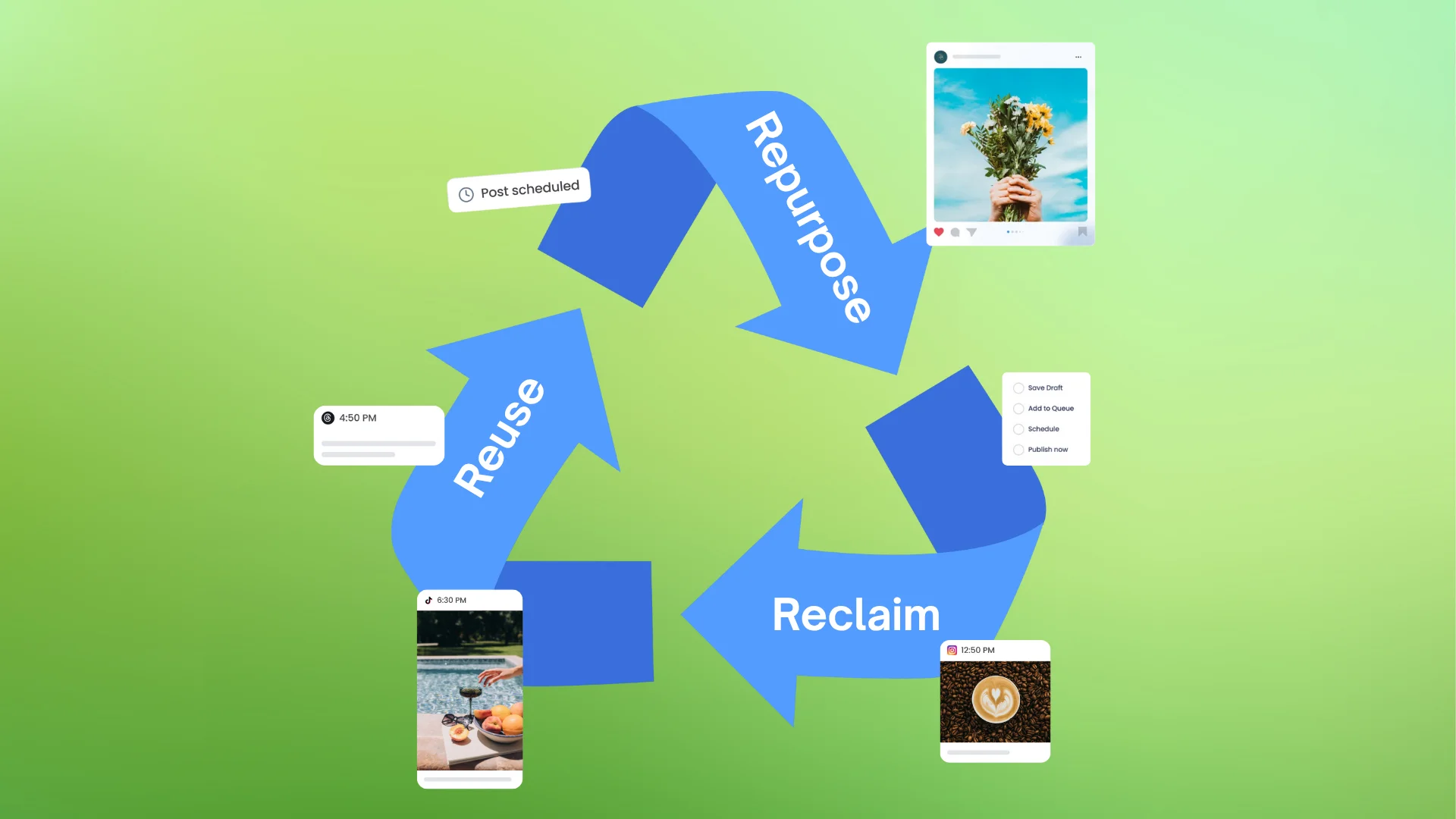
Mastering Content Reuse: The Key to a Consistent and Sustainable Posting Strategy
Published on November 17, 2025
9 min to read
How to Write a Professional LinkedIn Headline (+ Examples)
Summarize with AI
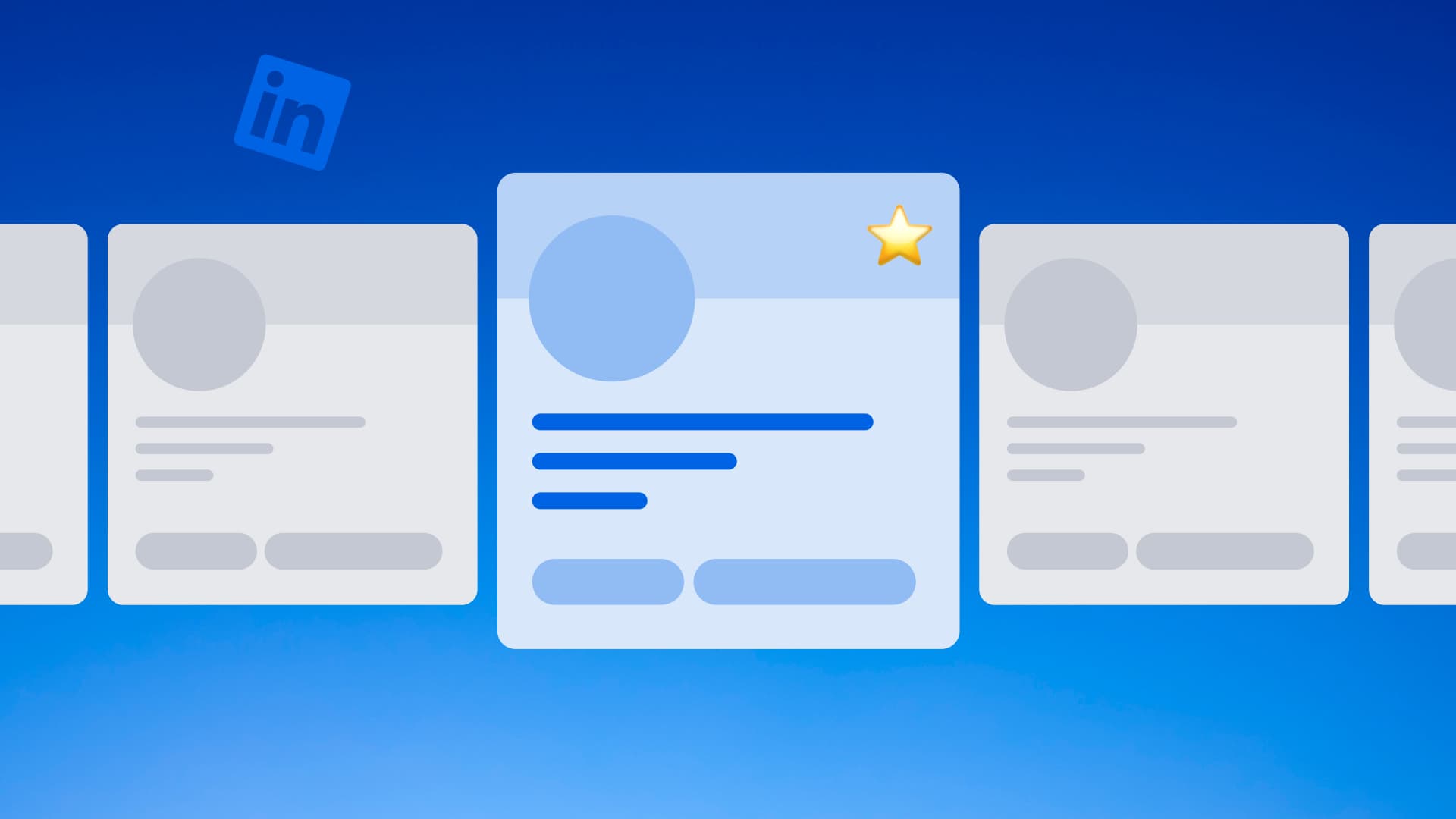

Table of Content

Your LinkedIn headline is your first chance to make a great impression. This small piece of text appears right under your name on your LinkedIn profile and shows up when people search for professionals like you.
Most people stick with the basic job title that LinkedIn creates for them, but that’s a missed chance to stand out. Your headline can be up to 220 characters long, giving you plenty of space to showcase what makes you special.
This guide will show you how to write a LinkedIn headline that grabs attention. You’ll learn what works, what doesn’t, and see real examples from marketing professionals.
Whether you’re building a LinkedIn business strategy or looking to improve your LinkedIn analytics, we’ll share tips on how Vista Social can help you manage your LinkedIn presence more effectively.
Table of contents
What is a LinkedIn headline?
A LinkedIn headline is the short text that appears directly under your name on your profile. It’s one of the first things people see when they look at your profile or find you in search results.
Your headline has a limit of 220 characters, but you don’t have to use them all. The key is making every word count. When someone views your profile in the LinkedIn feed, they only see the first part of your headline—this makes the very beginning even more important.
Here’s an example of what your LinkedIn headline could look like from our social media manager Alexus Brittain’s profile:
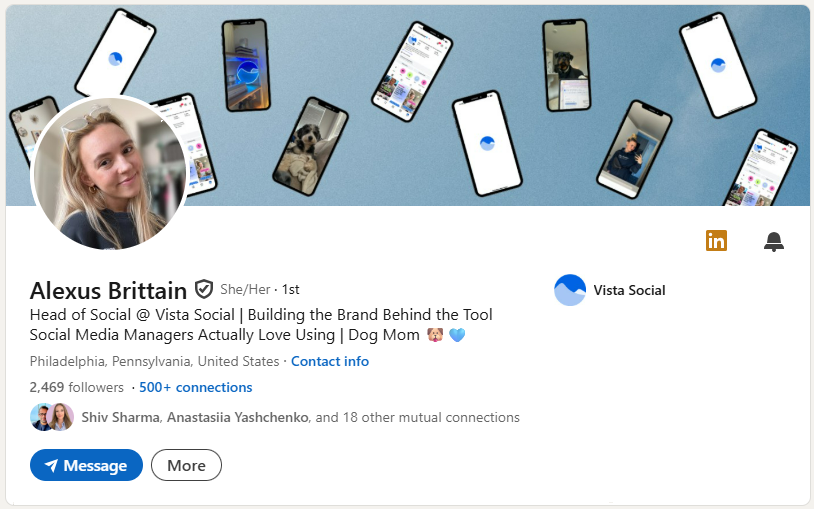
Alexus includes relevant personal details by adding “Dog Mom” with emojis, helping her connect with other pet lovers in her network. She explains what she does by positioning Vista Social as “the tool social media managers actually love using,” which serves as both a value proposition and product promotion.
Why is your LinkedIn headline important?
Your LinkedIn headline matters for several key reasons. When used strategically as part of your overall LinkedIn content strategy, it can significantly impact your professional success on the platform.
It affects your search ranking
LinkedIn uses keywords in headlines to match you with relevant searches. When recruiters look for marketing professionals, they search for terms like “social media manager” or “digital marketing.”
Having these keywords in your headline helps you show up in their results. Understanding how the LinkedIn algorithm works can help you optimize your headline for better visibility.
It creates a better first impression
Your headline is often the first thing people read about you. It appears in search results, connection requests, and when you comment on posts.
A strong headline can make someone want to click on your profile to learn more. This is especially important when participating in LinkedIn groups where your headline shows alongside every post or comment you make.
It shows your value quickly
People scan LinkedIn profiles fast. Your headline gives you a chance to communicate what you do and what makes you different in just seconds. This is especially important when networking or job hunting, as it can determine whether someone decides to connect with you or move on to the next profile.
It helps you get found by the right people
A clear, keyword-rich headline attracts the right connections. Whether you’re looking for clients, job opportunities, or industry contacts, your headline acts as a filter to bring in the people who matter most to your goals. This becomes even more powerful when combined with effective LinkedIn marketing tools to amplify your reach.
How to write a professional LinkedIn headline
Writing a great LinkedIn headline isn’t hard when you follow these steps. The key is to be strategic about every word you use, much like you would when creating any piece of content for your professional brand.
Look at how others phrase their headlines
Before writing your own headline, study profiles of successful people in your field. Look for patterns in how they structure their headlines and notice which keywords they use and how they describe their value.
Pay attention to headlines that catch your eye and consider what makes them interesting. Often, it’s the combination of clear job titles, specific skills, and measurable results that creates the most impact.
Highlight what you do
Start with your current role or the job you want. This gives people an immediate understanding of your professional identity.
Instead of just “Marketing Professional,” try “Social Media Marketing Manager” or “Digital Marketing Specialist.” Be specific about your area of focus. “Marketing Manager” is good, but “B2B SaaS Marketing Manager” is better because it tells people exactly what type of marketing you do.
Share your skills and expertise
Include key skills that showcase your core competencies and help you appear in relevant searches. Choose 2-3 skills that are most important for your target role.
For marketing professionals, this might include “SEO,” “Content Strategy,” or “Paid Advertising.” Think about the skills that recruiters or clients would search for, as these are the terms you want to include in your headline.
Include keywords relevant to your work
Industry jargon and job titles that decision-makers might use when searching should be part of your headline. Research job postings in your field to see which terms come up most often. But don’t just stuff keywords together—make sure your headline reads naturally and makes sense to humans, not just search engines.
Place the most important part first
LinkedIn truncates longer headlines in the feed, typically after around 70 or so characters. This means the beginning of your headline is the most valuable space, so put your job title or most important keyword at the start. This becomes especially important when you’re using features like boosting posts where your headline appears prominently.
Infuse some of your personality
While keeping things professional, you can add a touch of personality. This might be a passion for your work, a unique approach, or a specific mission. For example: “Social Media Manager | Passionate about building authentic brand communities.” This personal touch can help you stand out in a sea of similar professionals.
LinkedIn headline examples to inspire you
Here are real examples of effective LinkedIn headlines from marketing professionals to help inspire you as you craft your own.
1. Neil Patel
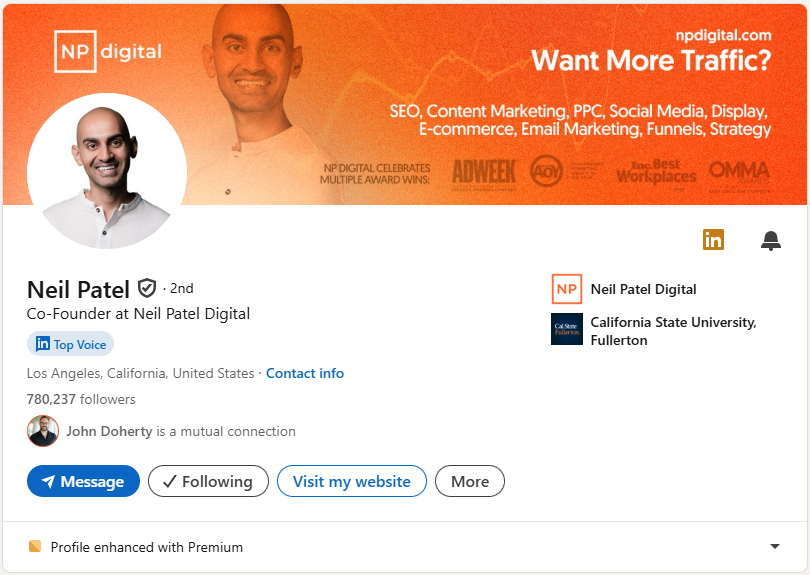
Neil keeps his headline straightforward by simply stating his role and company. This works because when you’re already well-known in your industry, you don’t need flashy language or long descriptions. Sometimes the most effective approach is to let your reputation speak for itself.
2. Sophie Miller
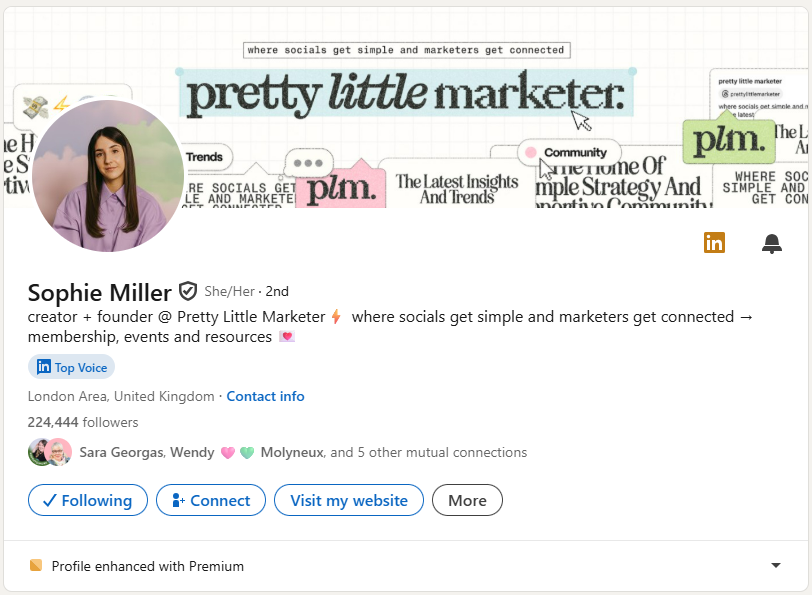
Sophie uses emojis strategically throughout her headline to match her brand personality. The lightning bolt, arrow, and heart emojis reflect Pretty Little Marketer’s signature style that her community expects. She also includes her value proposition (“where socials get simple”) right in the headline so people immediately understand what she offers.
3. Zaria Parvez
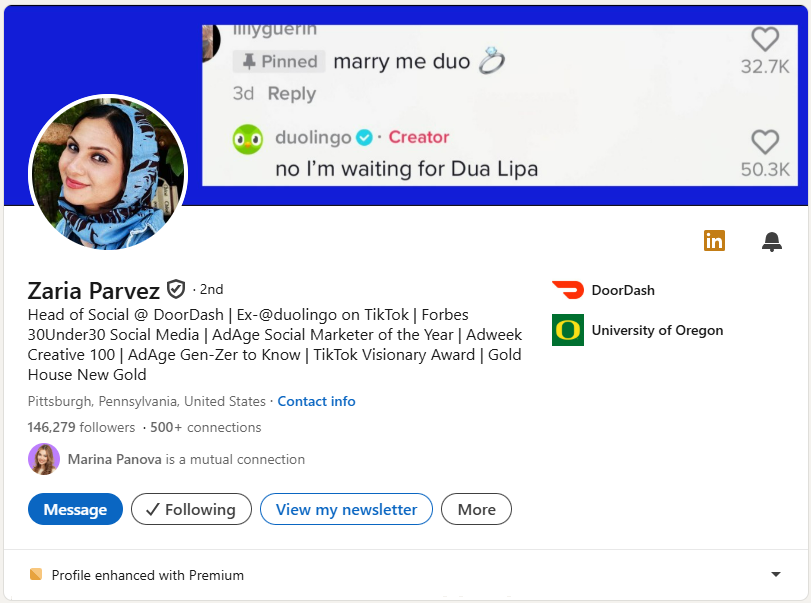
Zaria shares her accolades directly in her headline to establish immediate credibility. By listing prestigious awards from Forbes, AdAge, and Adweek, she provides concrete proof of her expertise. This approach works well when you have significant industry recognition that can speak for your abilities.
4. Daniel Korenblum
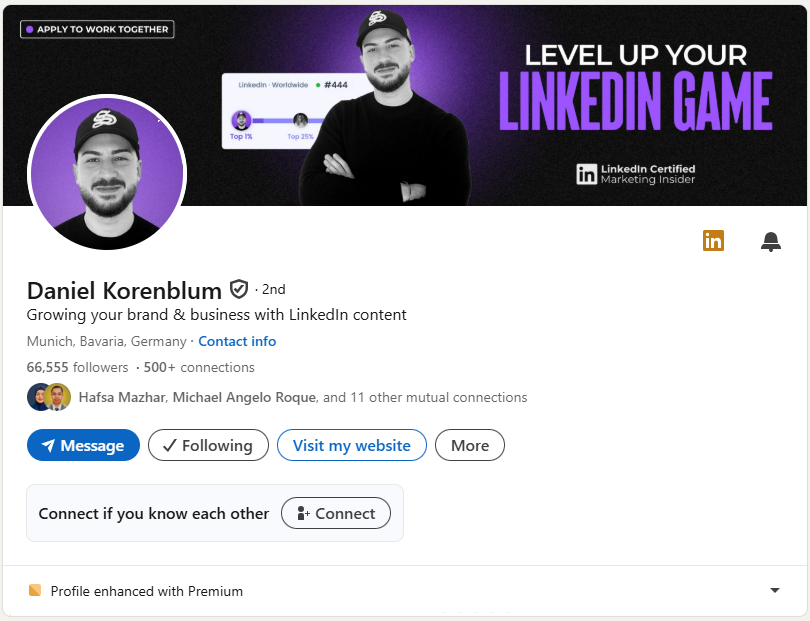
Daniel explains exactly what he does for clients rather than just listing his job title. This headline works as a clear value proposition that tells potential clients the specific outcome they can expect. It’s direct and focused on results rather than credentials.
5. Jon-Stephen Stansel
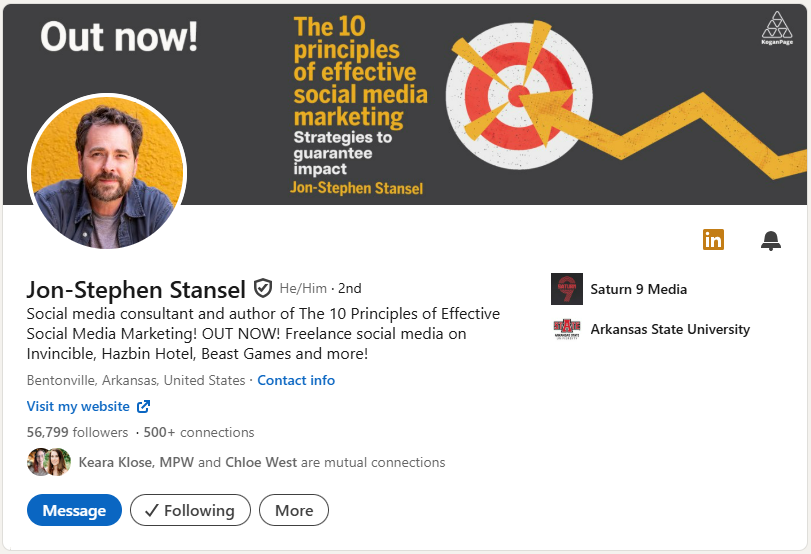
Jon-Stephen uses his LinkedIn headline to promote his book while also showcasing impressive clients. The “OUT NOW!” adds urgency and excitement to grab attention. Including high-profile entertainment clients provides social proof of his expertise in action.
6. Rachel Karten
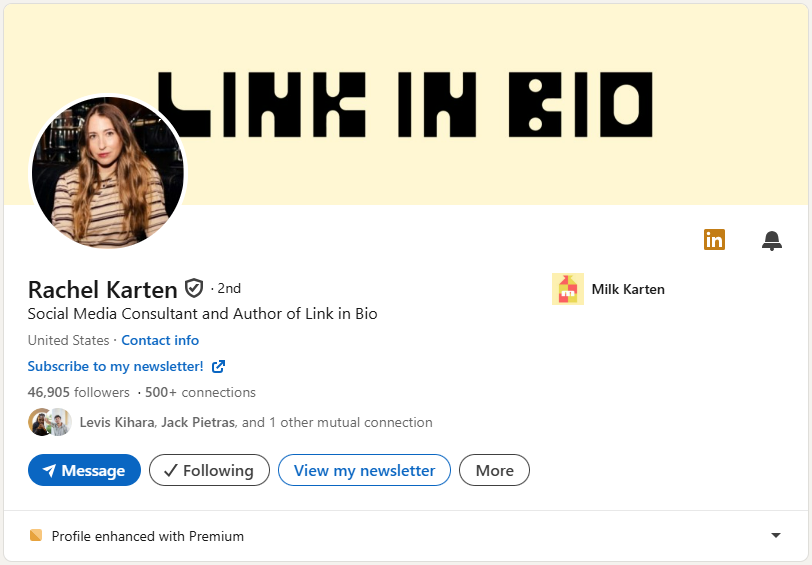
Rachel keeps it simple by stating her role and her well-known newsletter. When you have a recognized brand or publication, sometimes the straightforward approach works best. Her newsletter has strong industry recognition, so she doesn’t need additional explanation.
7. Jessica Walrack
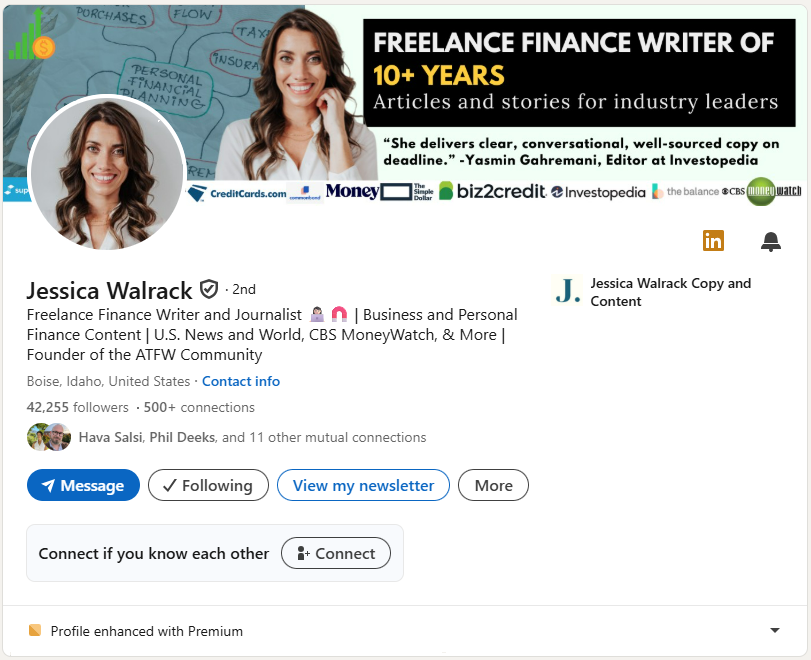
Try Vista Social for Free
A social media management platform that actually helps you grow with easy-to-use content planning, scheduling, engagement and analytics tools.
Get Started NowJessica includes her portfolio by mentioning prestigious publications she’s written for. The money and house emojis immediately signal her specialty area. She also promotes her community to show she’s building her own platform beyond client work.
8. Scott Frothingham
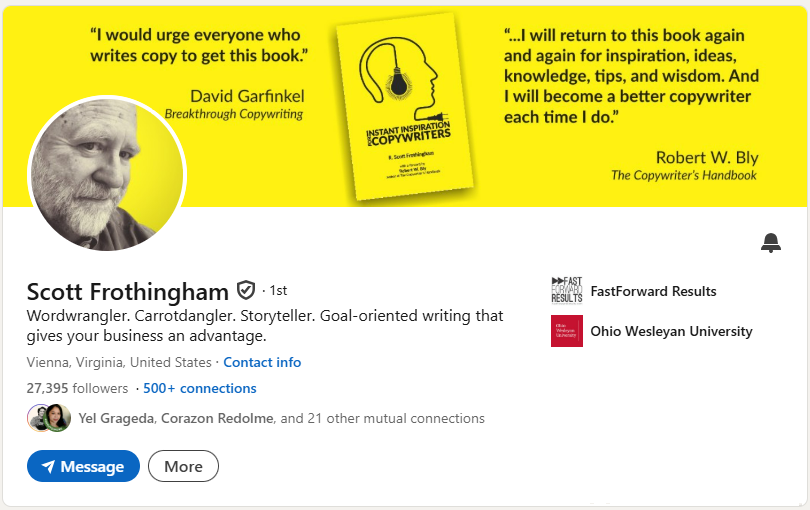
Scott uses buzzwords creatively to grab attention and showcase his personality. “Wordwrangler” and “Carrotdangler” are memorable terms that demonstrate his creativity as a copywriter. He balances personality with a clear business benefit in the second line.
9. Georgie Darling
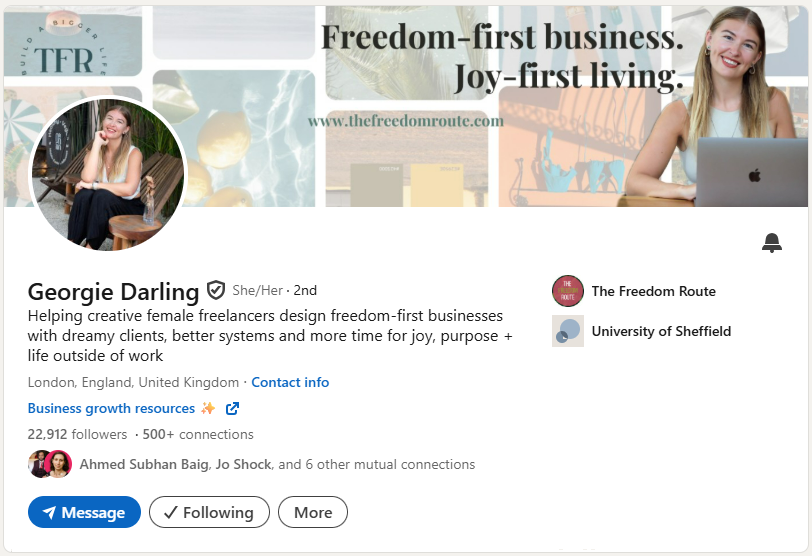
Georgie shares her mission clearly in her headline. She explains exactly who she helps (creative female freelancers) and what transformation she provides (freedom-first businesses). This approach attracts her ideal audience by speaking directly to their desires.
10. Tamilore Oladipo

Tamilore matches her voice and personal brand by keeping the headline casual and lowercase. The “on vacation” start shows personality and work-life balance. This relaxed approach aligns with her overall brand personality while still communicating her professional role.
11. Lizzie Davey
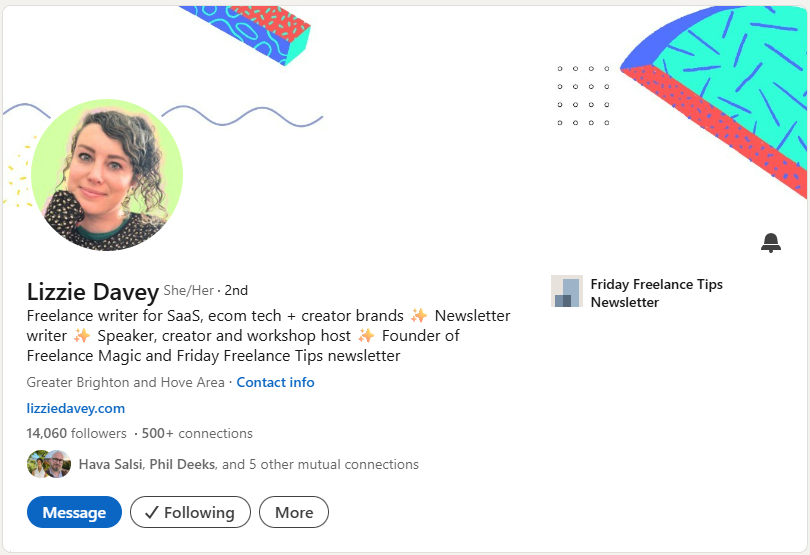
Lizzie shares multiple roles by listing all her different professional activities. The sparkle emojis add personality while maintaining professionalism. This approach shows the full scope of her expertise beyond just freelance writing.
12. Mya Shell
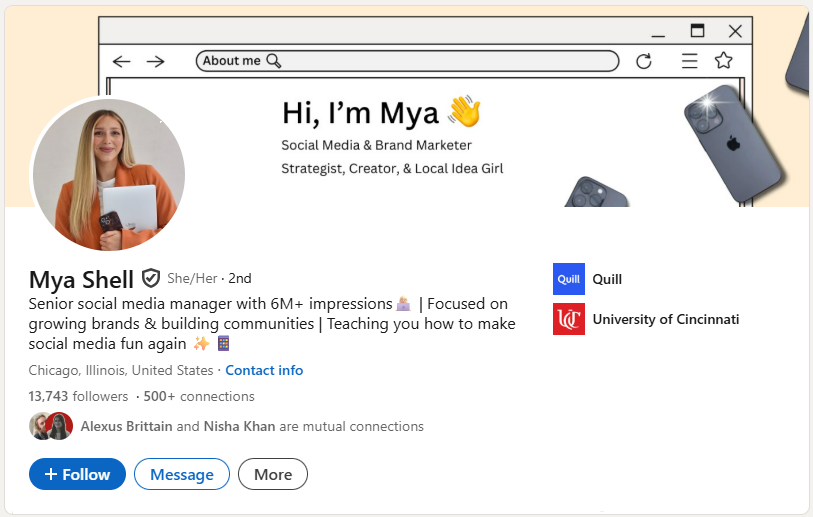
Mya shares her achievements by leading with concrete results (6M+ impressions). This tangible accomplishment immediately demonstrates her effectiveness. She also lets connections know what to expect from her content (making social media fun).
13. Tyler Hakes
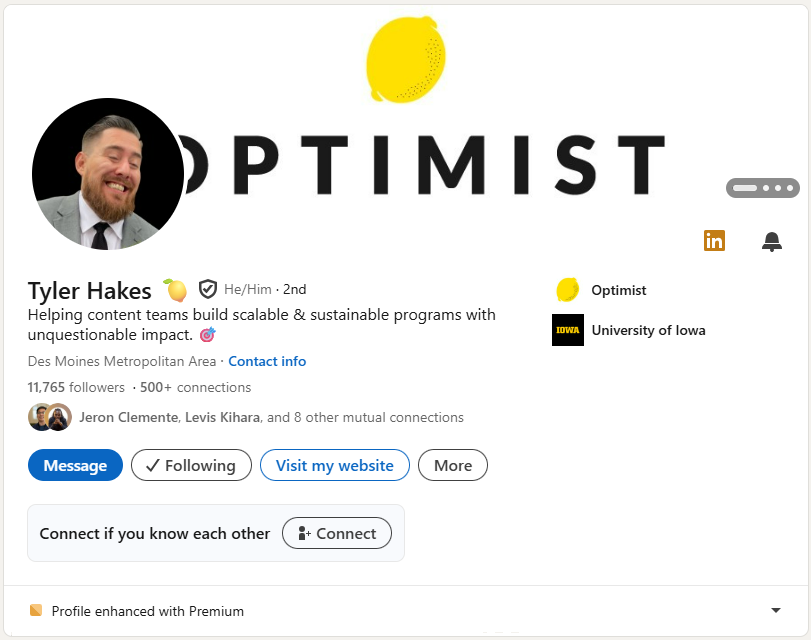
Tyler includes his value proposition by explaining exactly what he offers content teams. The cowboy emoji adds personality without undermining professionalism. This headline works as an elevator pitch for potential clients.
14. Alice Lemee
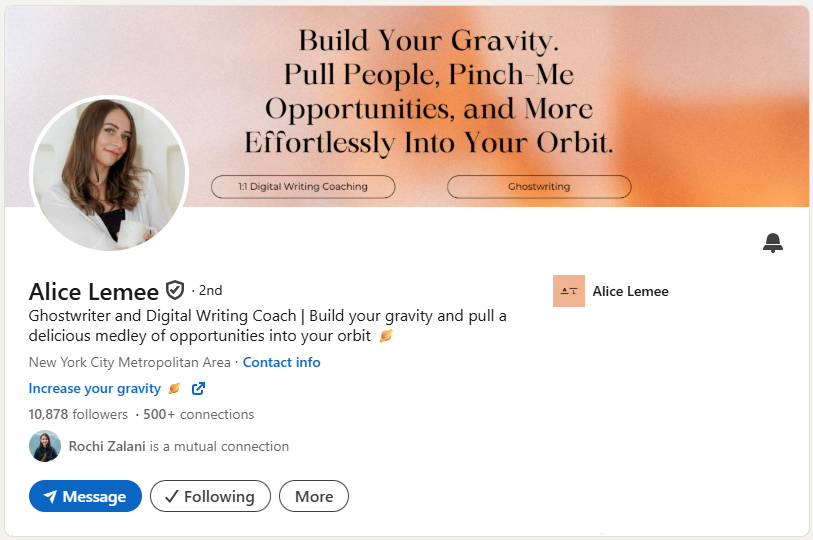
Alice showcases her personality through creative language while clearly stating her services. The “gravity” metaphor demonstrates her writing ability while the planet emoji reinforces the concept. This approach shows her skill as a writer through the headline itself.
15. Stefana Zarić

Stefana writes a list format to clearly organize her services and specialties. She targets a specific niche (SaaS businesses) then lists her service types and industry expertise. This structured approach makes it easy for potential clients to quickly assess fit.
16. Chi Thukral

Chi shares her accolades and impressive background to establish credibility. Leading with “Award Winning” immediately signals excellence, while “Forbes 30u30” and “ex-Hubspot” add prestigious recognition. This credential-stacking approach works well for building trust quickly.
17. Polly Clover
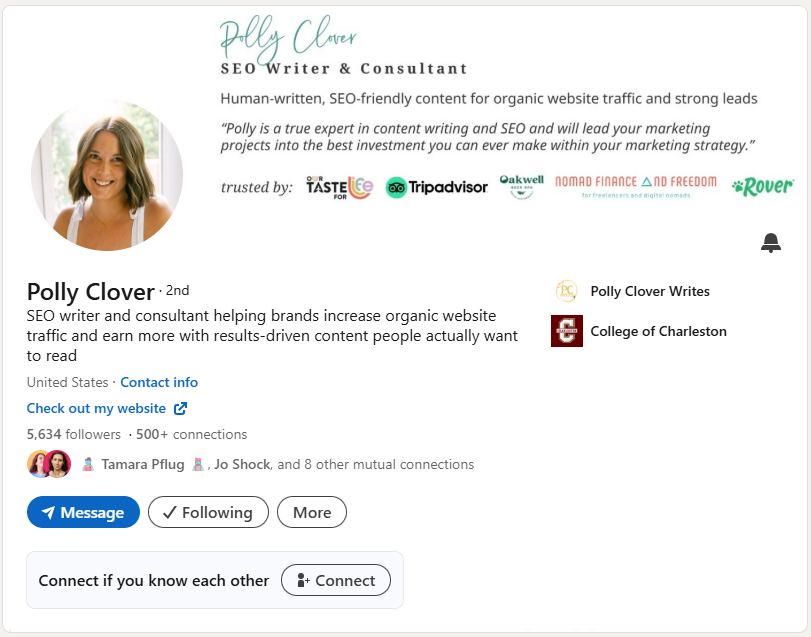
Polly explains what she does by focusing on specific outcomes for clients. Rather than just saying “SEO writer,” she details the results (increased traffic, more revenue) and addresses a key concern (readable content). This approach positions her services in terms of business value.
18. Hava Salsi
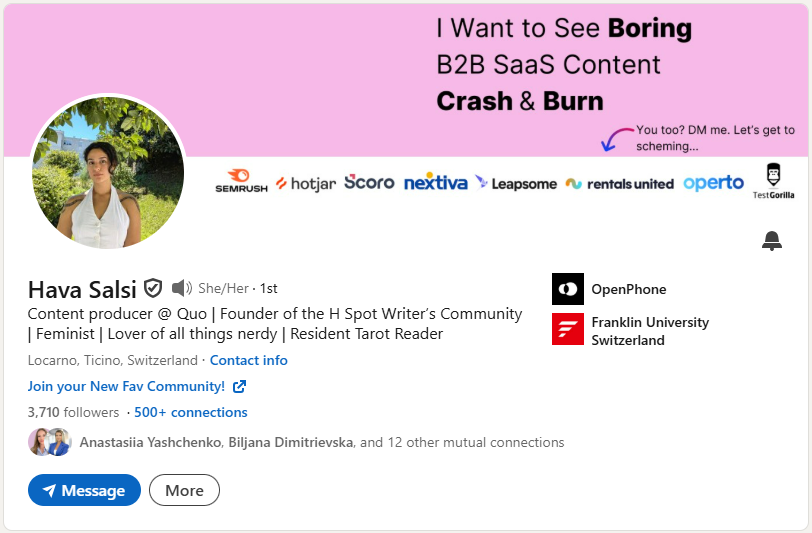
Hava includes relevant personal details that connect to her professional work and attract like-minded connections. The mix of professional role and personal interests creates a complete picture. This approach helps her stand out and build connections with people who share similar values.
19. Chloe West

Chloe shares multiple roles while adding personality through interests. The professional information establishes her expertise, while the personal touches (books, plants, soccer) make her more relatable. This balance helps her appear both competent and approachable.
20. Tayla Blaire
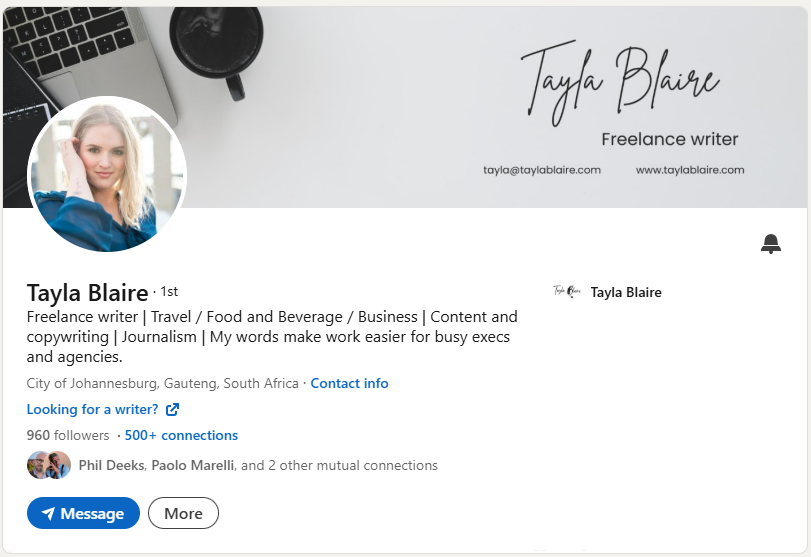
Tayla creates a tagline that functions as an elevator pitch. She clearly lists her specialties then ends with a value proposition that speaks to decision-makers’ pain points. This approach combines service clarity with a memorable benefit statement.
Boost your profile with a professional LinkedIn headline
Your LinkedIn headline is one of the most important parts of your profile. It’s your chance to make a strong first impression and show up in the right searches.
Remember to keep your language simple and clear, use specific numbers when you can, and include keywords that matter in your industry. Most importantly, make sure your headline reflects the unique value you bring to your work.
A great headline is just the beginning of building your professional presence. You also need to manage your LinkedIn presence effectively, which includes understanding what your audience wants through social listening.
Vista Social’s LinkedIn integration helps you schedule posts, track performance, and engage with your network from one central platform. You can connect both personal LinkedIn profiles and company pages, making it easier to maintain a consistent professional presence.
Whether you’re job hunting, building your network, or establishing thought leadership, your headline sets the stage for success on LinkedIn. Combined with the right tools and strategy, it becomes a powerful part of your overall professional brand.
Ready to take your LinkedIn presence to the next level? Try Vista Social’s LinkedIn tools to schedule, manage, and analyze your LinkedIn content more effectively.
LinkedIn headline FAQs
What is a good headline for a LinkedIn profile?
A good LinkedIn headline includes three key parts: your role or target job, your main skills, and what makes you different. It should be clear, specific, and include keywords that people in your industry search for. For example: “Marketing Manager | Content Strategy & SEO Expert | Helping SaaS Companies Increase Organic Traffic.”
What are good headline examples?
Here are some proven formulas:
- “Job Title | Key Skills | Unique Value”
- “Role | Industry Focus | Measurable Result”
- “Position | Expertise Areas | Target Audience You Help”
Examples: “Social Media Manager | B2B Content Creation | Growing Professional Services Brands” or “Digital Marketing Specialist | PPC & Analytics Expert | E-commerce Growth Strategist.”
What should my LinkedIn headline be if I’m unemployed?
Focus on your target role and skills rather than employment status. Use formats like:
- “Marketing Professional | Content Strategy & Social Media Expert | Open to New Opportunities”
- “Digital Marketing Specialist | SEO & Paid Advertising | Seeking Growth-Focused Role”
Avoid phrases like “Unemployed” or “Looking for work.” Instead, position yourself as the professional you are.
What is the character limit for LinkedIn headlines?
LinkedIn headlines have a maximum limit of 220 characters. However, LinkedIn truncates longer headlines in the feed, typically after around 210 characters. This means you should put your most important information in the first 200 characters to ensure it’s always visible.
About the Author
Content Writer
Russell Tan is a content marketing specialist with over 7 years of experience creating content across gaming, healthcare, outdoor hospitality, and travel—because sticking to just one industry would’ve been boring. Outside of her current role as marketing specialist for Vista Social, Russell is busy plotting epic action-fantasy worlds, chasing adrenaline rushes (skydiving is next, maybe?), or racking up way too many hours in her favorite games.
Read with AI
Save time reading this article using your favorite AI tool
Summarize with AI
Never Miss a Trend
Our newsletter is packed with the hottest posts and latest news in social media.
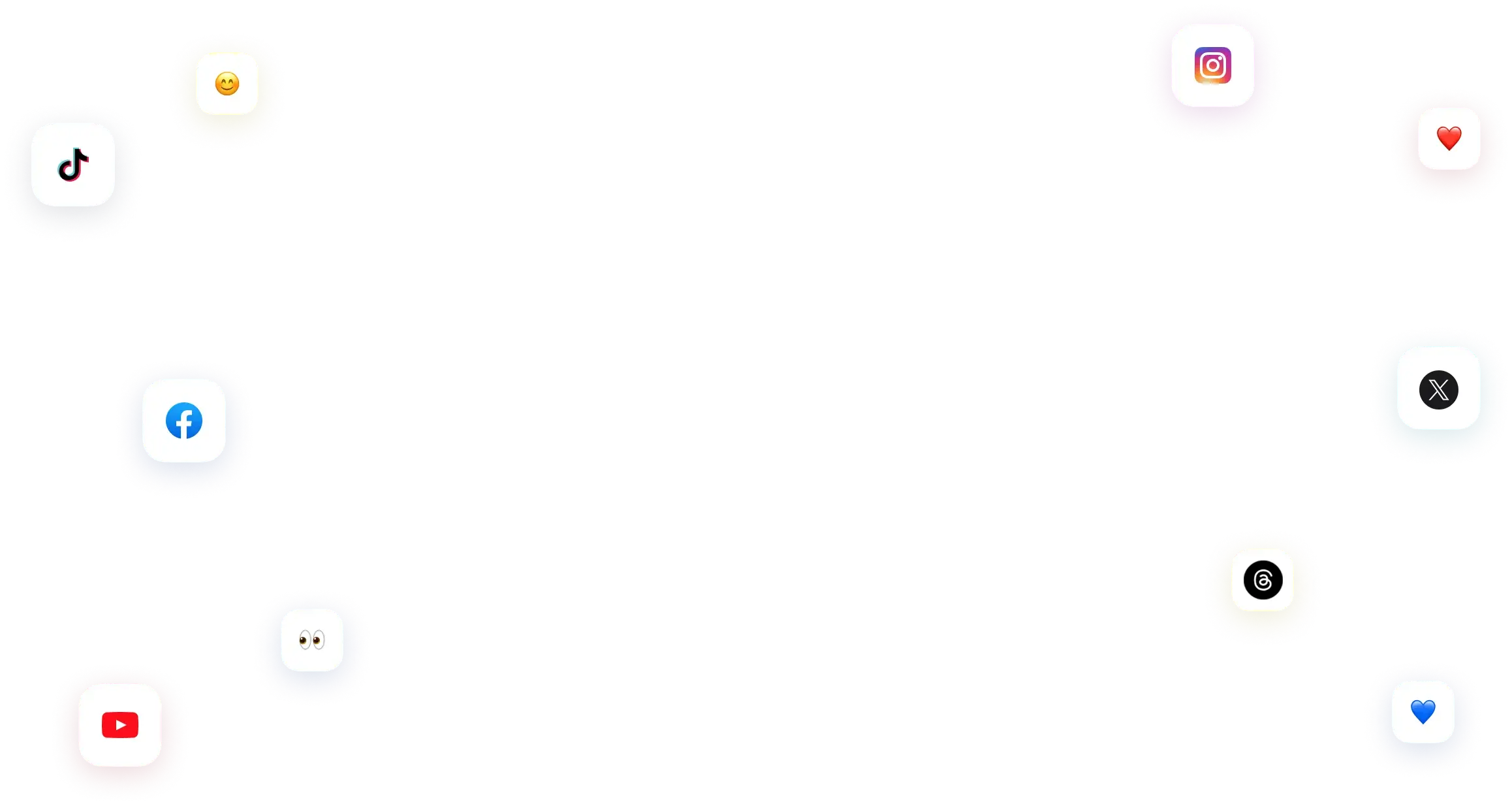
You have many things to do.
Let us help you with social media.
Use our free plan to build momentum for your social media presence.
Or skip ahead and try our paid plan to scale your social media efforts.
P.S. It will be a piece of cake 🍰 with Vista Social
Subscribe to our Newsletter!
To stay updated on the latest and greatest Social Media news. We promise not to spam you!


